|
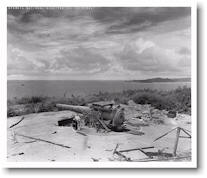
Battery Hearn
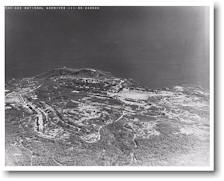
Pre-Invasion photograph: Middleside Barracks, Hospital, Btty. Way, Mile
Long Barracks, NCO Married Qtrs., Cine, Officers Row, Post HQ., Btty.
Wheeler (far right) Light House, Water Towers, Senior Officers Row, Golf
Course, Btty Geary, Btty. Crockett.

Landing Field B; Officers Swimming Pool;C-47, stick of 7;
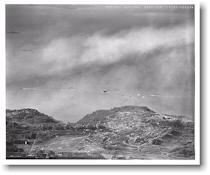
Landing Zone A; Mile Long Barracks; Cine; Post HQ, Senior Officers
Residences; C-47 Parachute
Drop; Landing craft; 532nd Engineer Boat & Shore Regiment; USN;
Destroyers; cruiser.
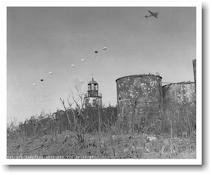
Landing
Zone B; Lighthouse; Water Tanks;C-47 Parachute Drop; stick of 7.
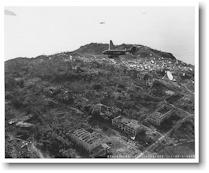
Ciné; BOQ;Post HQ; Lighthouse; Senior Officer's Row; Landing Zone B;
Btry Crockett; |

|
The prospective cost of amphibious assault
was, indeed, one of the chief factors that led to a decision to
use paratroopers. Planners saw the obvious risks in sending
parachute troops against such a small and rough target, but in
view of the GHQ SWPA estimate that the Japanese garrison
numbered only 850 men, the cost of the airborne operation
promised to be less than that involved in an amphibious attack.
Krueger intended to land almost 3,000 troops on Corregidor on 16
February, over 2,000 of them by parachute. Another 1,000 men or
more would come in by parachute or landing craft the next day.
Planners hoped that such preponderant strength, combined with
intensive air and naval bombardment, might render the seizure of
the island nearly bloodless.
An equally important (if not even more
decisive) factor leading to the decision to employ paratroops
was the desire to achieve surprise. GHQ SWPA and Sixth Army
planners hoped that the Japanese on Corregidor would judge that
no one in his right mind would even consider dropping a regiment
of parachutists on such a target. The defenses, the planners
thought, would probably be oriented entirely toward amphibious
attack.
There was only one really suitable dropping
ground on Corregidor, a prewar landing strip, known as Kindley
Field, on the central part of the tail. This area was quite
small and, not having been utilized by the Japanese, badly
overgrown. Nevertheless, Col. George M. Jones, commanding the
503d RCT, recommended that Kindley Field be used as the drop
ground after he had made a personal aerial reconnaissance over
the island. 6 General
Krueger overruled the proposal quickly. A drop at Kindley Field,
he thought, would not place the 'troopers on the key terrain
feature quickly enough, and, worse, the men landing on the
airstrip would be subjected to the same plunging fire that
troops making an amphibious assault would have to face.
The only other possible locations for
dropping paratroopers were a parade ground and a golf course on
Topside, which was otherwise nearly covered by the ruins of
prewar barracks, officers' homes, headquarters buildings, gun
positions, and other artillery installations. The parade ground
provided a drop zone--that is, an area not dotted with damaged
buildings and other obstacles--325 yards long and 250 yards
wide; the sloping golf course landing area was roughly 350 yards
long and 185 yards wide. Both were surrounded by tangled
undergrowth that had sprung up since 1942, by trees shattered
during air and naval bombardments, and by wrecked buildings,
while the open areas were pockmarked by bomb and shell craters
and littered with debris as well. Both fell off sharply at the
edges and, on the west and south, gave way to steep cliffs.
Despite these disadvantages, planners selected the parade ground
and the golf course as the sites for the 503d's drop. The
planners based this decision largely upon the thought that if
the Japanese considered the possibility of a parachute invasion
at all, they certainly would not expect a drop on Topside. 7
In formulating final plans for the drop,
planners had to correlate factors of wind direction and
velocity, the speed and flight direction of the C-47 aircraft
from which the 503d RCT would jump, the optimum height for the
planes during the drop, the time the paratroopers would take to
reach the ground, the 'troopers' drift during their descent, and
the best flight formation for the C-47's. Planners expected an
easterly wind of fifteen to twenty-five miles per hour with
gusts of higher velocity. The direction corresponded roughly to
the long axes of the drop zones, but even so, each C-47 could
not be over the dropping grounds for more than six seconds. With
each man taking a half second to get out of the plane and
another twenty-five seconds to reach the ground from the planned
drop altitude of 400 feet, the wind would cause each paratrooper
to drift about 250 feet westward during his descent. This amount
of drift would leave no more than 100 yards of ground distance
at each drop zone to allow for human error or sharp changes in
the wind's speed or direction.
The 503d RCT and the 317th Troop Carrier
Group--whose C-47's were to transport and drop the
paratroopers--decided to employ a flight pattern providing for
two columns of C-47's, one column over each drop zone. The
direction of flight would have to be from southwest to northeast
because the best line of approach--west to east--would not leave
sufficient room between the two plane columns and would bring
the aircraft more quickly over Manila Bay, increasing the
chances that men would drop into the water or over cliffs. Since
each plane could be over the drop zone only six seconds, each
would have to make two or three passes, dropping a "stick" of
six to eight 'troopers each time. It would be an hour or more
before the 1,000 or so troops of the first airlift would be on
the ground. Then, the C-47's would have to return to Mindoro,
reload, and bring a second lift forward. This second group would
not be on the ground until some five hours after the men of the
first lift had started jumping.
Planners knew that they were violating the
airborne experts' corollary to ground warfare's principal of
mass--that is, to get the maximum force on the ground in the
minimum time. But there was no choice. Terrain and
meteorological conditions played their share in the formulation
of the plan; lack of troop-carrying aircraft and pilots trained
for parachute operations did the rest. The margin of safety was
practically zero, and the hazards were such that planners were
reconciled to accepting a jump casualty rate as high as 20
percent--Colonel Jones estimated that casualties might run as
high as 50 percent. To some extent the casualty rate would
depend upon whether or not the parachute drop took the Japanese
on Corregidor by surprise. And, if air and naval bombardments
had not reduced the Japanese on Topside to near impotency by the
time of the drop, a tragic shambles might ensue.
Planners were also concerned over casualties
during the amphibious phase of the assault, for they realized
that losses could run even higher during landings on the beach
than during the parachute drop. But the planners had several
important
reasons for including the amphibious attack, primary among them
being the difficult problem of aerial resupply and the
impossibility of aerial evacuation. Amphibious assault troops,
planners believed, would probably be able to establish an early
contact with the paratroopers on Topside and thus open an
overwater supply and evacuation route.
|
|
   |
|
|

|
|
|

